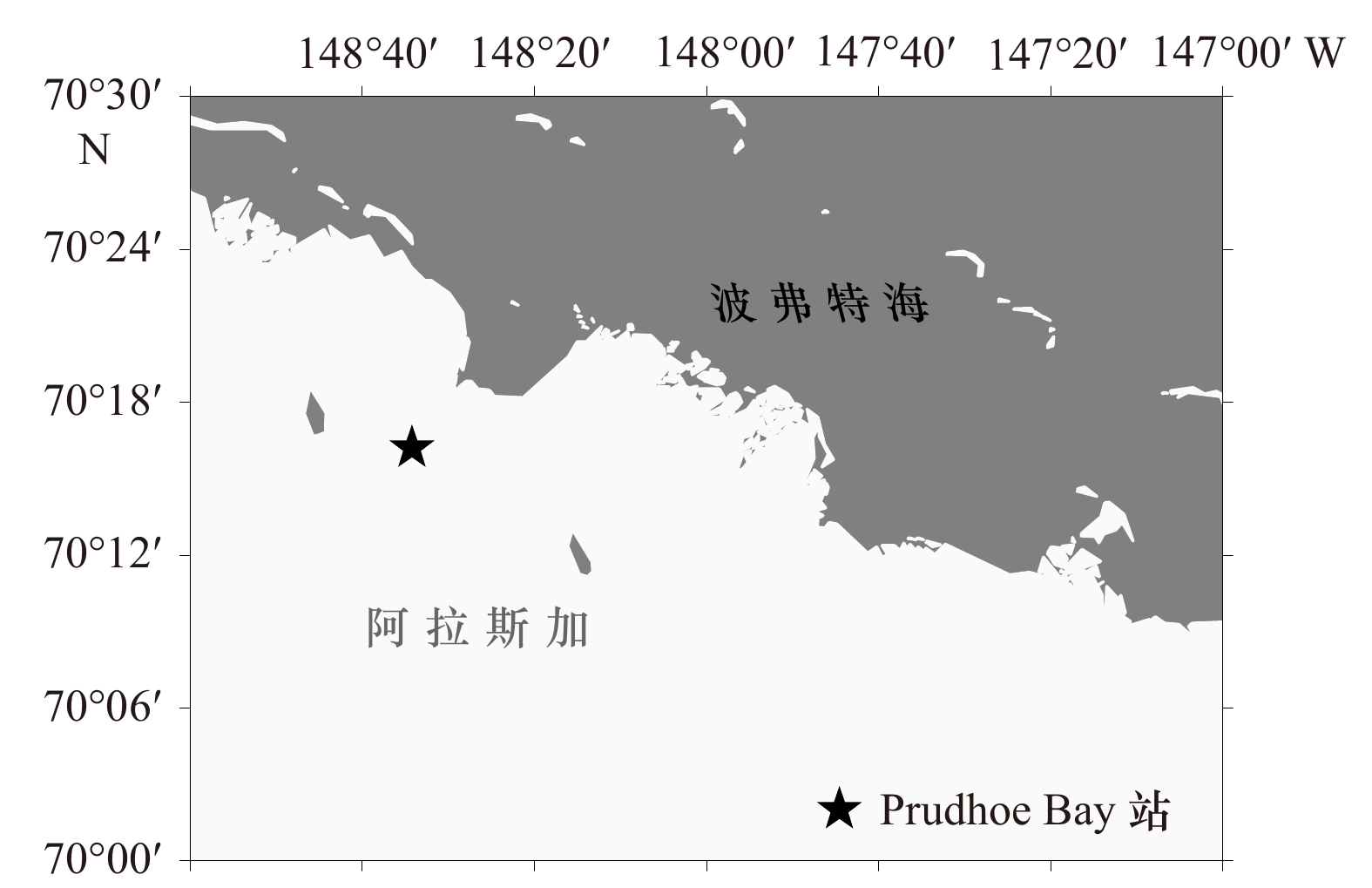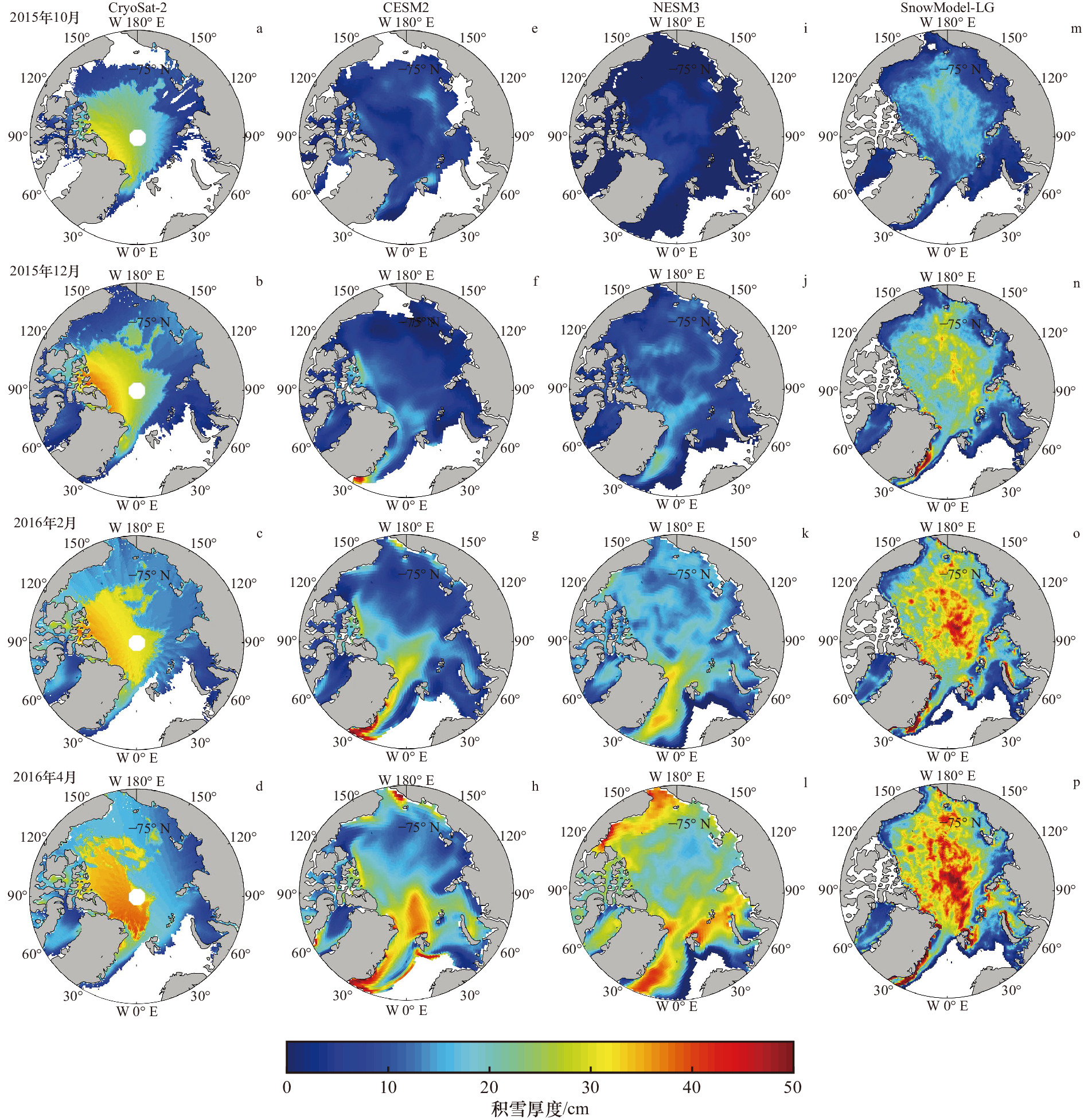Sensitivity study of constant and variable snow density schemes in diagnosing and calculating snow depth
-
摘要: 海冰上积雪的分布是影响海冰与大气能量交换以及气候变化的重要因素。当前的CMIP6气候模式(如CESM2和NESM3)采用定常的积雪密度,而专注于模拟雪厚度和密度变化的模式(如SnowModel-LG)则采用经验的变化雪密度公式。对比CryoSat-2卫星观测的积雪厚度发现,从积雪厚度的空间分布与平均值难以判断出变化雪密度对北冰洋积雪厚度模拟产生何种影响,对于变化雪密度模拟积雪厚度的改进及机制有待进一步研究。本文采用随气温、风速等因子变化的雪密度经验公式模型,并利用SNOTEL单站的长时间序列观测资料,对不同影响因子设计如下敏感性实验:A. 考虑所有气象因子的变化雪密度模型;B. 常数雪密度模型;C. 在A中不考虑风对密实化的影响;D. 在A中不考虑气温对密实化的影响。实验A、B、C和D诊断计算的2018年11月1日至2019年5月10日积雪厚度的均方根误差分别为4.2 cm、4.8 cm、25.9 cm和4.2 cm。结果表明,变化雪密度方案A模拟的积雪密度、厚度在平均值上与常数雪密度的结果接近,但其模拟的积雪厚度均方根误差最小,并且能够模拟出积雪厚度在几天到十几天时间尺度上的高频变化,同时减小了这种高频变化对应时段雪厚模拟结果的相对误差,二者具有一定的相关性。此外,还发现气温变化对积雪密实化的影响远小于风。Abstract: Current CMIP6 climate models (such as CESM2 and NESM3) use constant snow density, while those models that focus on snow depth and density changes (such as SnowModel-LG) use empirical snow density formulas. Comparing the modeled snow depth with those observed by the CryoSat-2 satellite, it is found that from the perspective of the spatial distribution and average value of the snow depth, it is difficult to detect the effects of varying snow density on the simulation of snow depth in the Arctic Ocean. The model improvement and its mechanism from varying snow depth is still to be further studied. Here an empirical snow density model considering meteorological factors such as air temperature, wind etc., is applied to the SNOTEL observational site to carry out the following sensitivity experiments for different factors: A. snow density model considering all meteorological factors; B. constant snow density model; C. same as A but the influence of wind on the densification is not considered and D. same as A but the influence of temperature on the densification is not considered. The root mean square error of snow depth simulated by experiments A, B, C and D from November 1, 2018 to May 10, 2019 are 4.2 cm, 4.8 cm, 25.9 cm, and 4.2 cm, respectively. The results show that the mean snow density and depth simulated by the varying snow density model are close to the results using constant snow density, but the root mean square error of the simulated snow depth from Case A is the smallest, and the Case A simulation can reproduce the high frequency variations of snow depth on the time scale of several days to ten days. In the meantime, the relative errors in the period with high-frequency snow depth variations are also reduced as they are found to be related. In addition, it is also found that the influence of temperature on snow densification is much smaller than that of wind.
-
Key words:
- climate model /
- Arctic /
- snow depth /
- snow density
-
图 2 CryoSat-2卫星观测的(a−d)与采用不同积雪密度的模式(CESM2(e−h)、NESM3(i−l)和SnowModel-LG(m−p))模拟的北冰洋2015年10月至2018年4月的3年平均的10月、12月、2月和4月积雪厚度
Fig. 2 October, December, February and April snow depth averaged between October 2015 to April 2018 observed by CryoSat-2 (a−d) and modeled by CESM2 (e−h), NESM3 (i−l) and SnowModel-LG (m−p) over the Arctic
图 3 CryoSat-2卫星观测的(a−d)与采用不同雪密度的模式(CESM2(e−h)、NESM3(i−l)和SnowModel-LG(m−p))模拟的北冰洋2015年10月、12月与2016年2月、4月平均积雪厚度
Fig. 3 Snow depth of October, December in 2015 and Febraury, April in 2016 between observed by CryoSat-2 (a−d) and modeled by CESM2 (e−h), NESM3 (i−l) and SnowModel-LG (m−p) over the Arctic
图 6 实验A和B模拟的普拉德霍湾站积雪厚度的相对误差
由于实验C的积雪厚度相对误差远大于其余三者,且实验D的结果与实验A的一致,故不展示
Fig. 6 Relative errors of modeled snow depth in cases A and B at Prudhoe Bay Station
Since the relative error of snow depth in Case C is more than three times as much as the other three and the result of Case D is almost consistent with that of Case A, it is not shown in the figure
表 1 CESM2、NESM3和SnowModel-LG的分量模式比较
Tab. 1 Comparison of component models among CESM2, NESM3 and SnowModel-LG
模式分量 CESM2 NESM3 SnowModel-LG 大气 CAM6 ECHAM v6.3 ERA5; MERRA2;
自动气象站数据海洋 POP2 NEMO v3.4 − 陆地 CLM5 JSBACH v3.1 − 海洋生物化学 MARBL − − 气溶胶 MAM4 − − 大气化学 MAM4 − − 海冰 CICE5.1 CICE4.1 海冰地形、海冰位置和
海冰密集度数据陆地冰 CISM4.1 − − 注:−代表模式不包含该分量。 表 2 实验A、B、C和D模拟的普拉德霍湾站积雪厚度的均方根误差与相关系数
Tab. 2 Root mean square errors and correlation coefficients of snow depth in cases A, B, C and D at Prudhoe Bay Station
方案 均方根误差/cm 总体相关系数 2018年10月(4−31日) 2018年11月 2018年12月 2019年1月 2019年2月 2019年3月 2019年4月 2019年5月(1−10日) 总体 A 2.4 4.8 5.8 4.5 2.2 1.8 2.9 7.5 4.2 0.82 B 2.7 4.5 9.4 2.8 1.4 2.8 4.3 1.4 4.8 0.80 C 6.1 18.5 25.6 35.2 27.4 25.3 23.5 15.8 25.9 0.67 D 2.4 4.8 5.8 4.6 2.2 1.8 2.9 7.4 4.2 0.82 -
[1] 李淑江, 赵进平, 李翔, 等. 北极冰上积雪的光学衰减性质[J]. 中国海洋大学学报(自然科学版), 2010, 40(7): 9−14.Li Shujiang, Zhao Jinping, Li Xiang, et al. The optical properties of snow on the ice in the north polar region[J]. Periodical of Ocean University of China, 2010, 40(7): 9−14. [2] Wu X, Budd W F, Lytle V I, et al. The effect of snow on Antarctic sea ice simulations in a coupled atmosphere-sea ice model[J]. Climate Dynamics, 1999, 15(2): 127−143. doi: 10.1007/s003820050272 [3] Ek M B, Mitchell K E, Lin Y, et al. Implementation of Noah land surface model advances in the National Centers for Environmental Prediction operational mesoscale Eta model[J]. Journal of Geophysical Research: Atmospheres, 2003, 108(D22): 8851. [4] Meløysund V, Leira B, Høiseth K V, et al. Predicting snow density using meteorological data[J]. Meteorological Applications, 2007, 14(4): 413−423. doi: 10.1002/met.40 [5] Black R F. Precipitation at Barrow, Alaska, greater than recorded[J]. Eos, Transactions American Geophysical Union, 1954, 35(2): 203−207. doi: 10.1029/TR035i002p00203 [6] Gottlieb L. Development and applications of a runoff model for snowcovered and glacierized basins[J]. Hydrology Research, 1980, 11(5): 255−272. doi: 10.2166/nh.1980.0013 [7] Verseghy D L. Class-A Canadian land surface scheme for GCMS. I. soil model[J]. International Journal of Climatology, 1991, 11(2): 111−133. [8] Radionov V F, Bryazgin N N, Alexandrov E I. The snow cover of the Arctic Basin[R]. Washington: Applied Physics Laboratory, University of Washington, 1997. [9] Warren S G, Rigor I G, Untersteiner N, et al. Snow depth on Arctic sea ice[J]. Journal of Climate, 1999, 12(6): 1814−1829. doi: 10.1175/1520-0442(1999)012<1814:SDOASI>2.0.CO;2 [10] Liston G E, Itkin P, Stroeve J, et al. A lagrangian snow-evolution system for sea-ice applications (SnowModel-LG): part I-model description[J]. Journal of Geophysical Research: Oceans, 2020, 125(10): e2019JC015913. [11] Hedstrom N R, Pomeroy J W. Measurements and modelling of snow interception in the boreal forest[J]. Hydrological Processes, 1998, 12(10/11): 1611−1625. [12] Pomeroy J W, Gray D M, Shook K R, et al. An evaluation of snow accumulation and ablation processes for land surface modelling[J]. Hydrological Processes, 1998, 12(15): 2339−2367. doi: 10.1002/(SICI)1099-1085(199812)12:15<2339::AID-HYP800>3.0.CO;2-L [13] Hellstrom R Å. Forest cover algorithms for estimating meteorological forcing in a numerical snow model[J]. Hydrological Processes, 2000, 14(18): 3239−3256. doi: 10.1002/1099-1085(20001230)14:18<3239::AID-HYP201>3.0.CO;2-O [14] Bartlett P A, MacKay M D, Verseghy D L. Modified snow algorithms in the Canadian land surface scheme: model runs and sensitivity analysis at three boreal forest stands[J]. Atmosphere-Ocean, 2006, 44(3): 207−222. doi: 10.3137/ao.440301 [15] Anderson E A. A point energy and mass balance model of a snow cover[R]. Washington: United States, National Weather Service, 1976. [16] 陆恒, 魏文寿, 刘明哲, 等. 天山季节性积雪稳定期雪密度与积累速率的观测分析[J]. 冰川冻土, 2011, 33(2): 374−380.Lu Heng, Wei Wenshou, Liu Mingzhe, et al. Densification and accumulation rate of snow in the stable snow cover period in the Tianshan Mountains[J]. Journal of Glaciology and Geocryology, 2011, 33(2): 374−380. [17] Lundberg A, Feiccabrino J. Sea ice growth: modeling of precipitation phase[C]//Proceedings of the 20th International Conference on Port and Ocean Engineering under Arctic Conditions. Lulea: Port and Ocean Engineering under Arctic Conditions, 2009. [18] Avanzi F, Michele C D, Ghezzi A. On the performances of empirical regressions for the estimation of bulk snow density[J]. Geografia Fisica e Dinamica Quaternaria, 2015, 38: 105−112. [19] Diamond M, Lowry W P. Correlation of density of new snow with 700-millibar temperature[J]. Journal of Meteorology, 1954, 11(6): 512−513. doi: 10.1175/1520-0469(1954)011<0512:codons>2.0.co;2 [20] Webster M A, Parker C, Boisvert L, et al. The role of cyclone activity in snow accumulation on Arctic sea ice[J]. Nature Communications, 2019, 10(1): 5285. doi: 10.1038/s41467-019-13299-8 [21] Eicken H, Fischer H, Lemke P. Effects of the snow cover on Antarctic sea ice and potential modulation of its response to climate change[J]. Annals of Glaciology, 1995, 21: 369−376. doi: 10.1017/S0260305500016086 [22] Schramm J L, Holland M M, Curry J A. The effects of snowfall on a snow-ice-thickness distribution[J]. Annals of Glaciology, 1997, 25: 287−291. doi: 10.3189/S0260305500014178 [23] 李志军, 张占海. 中国2003年北极海冰调查及未来北极海冰研究战略[J]. 极地研究, 2004, 16(3): 202−210.Li Zhijun, Zhang Zhanhai. Sea ice investigation in chiare-2003 and future Arctic ice research tactic[J]. Chinese Journal of Polar Research, 2004, 16(3): 202−210. [24] 王学忠, 孙照渤, 胡邦辉. 近年来国外海冰模式发展的回顾[J]. 南京气象学院学报, 2003, 26(3): 424−432.Wang Xuezhong, Sun Zhaobo, Hu Banghui. A review on development of sea ice model in foreign countries during recent years[J]. Journal of Nanjing Institute of Meteorology, 2003, 26(3): 424−432. [25] Langehaug H R, Geyer F, Smedsrud L H, et al. Arctic sea ice decline and ice export in the CMIP5 historical simulations[J]. Ocean Modelling, 2013, 71: 114−126. doi: 10.1016/j.ocemod.2012.12.006 [26] Notz D, SIMIP Community. Arctic sea ice in CMIP6[J]. Geophysical Research Letters, 2020, 47(10): e2019GL086749. [27] De Michele C, Avanzi F, Ghezzi A, et al. Investigating the dynamics of bulk snow density in dry and wet conditions using a one-dimensional model[J]. The Cryosphere, 2013, 7(2): 433−444. doi: 10.5194/tc-7-433-2013 [28] Blanchard-Wrigglesworth E, Webster M A, Farrell S L, et al. Reconstruction of snow on Arctic sea ice[J]. Journal of Geophysical Research: Oceans, 2018, 123(5): 3588−3602. doi: 10.1002/2017JC013364 [29] Petty A A, Webster M, Boisvert L, et al. The NASA Eulerian Snow on sea ice model (NESOSIM) v1.0: initial model development and analysis[J]. Geoscientific Model Development, 2018, 11(11): 4577−4602. doi: 10.5194/gmd-11-4577-2018 [30] Stroeve J, Liston G E, Buzzard S, et al. A lagrangian snow evolution system for sea ice applications (SnowModel-LG): part II—analyses[J]. Journal of Geophysical Research: Oceans, 2020, 125(10): e2019JC015900. [31] Bromwich D H. Snowfall in high southern latitudes[J]. Reviews of Geophysics, 1988, 26(1): 149−168. doi: 10.1029/RG026i001p00149 [32] Bromwich D H, Robasky F M, Cullather R I, et al. The atmospheric hydrologic cycle over the southern ocean and Antarctica from operational numerical analyses[J]. Monthly Weather Review, 1995, 123(12): 3518−3538. doi: 10.1175/1520-0493(1995)123<3518:TAHCOT>2.0.CO;2 [33] Huwald H, Tremblay L B, Blatter H. Reconciling different observational data sets from Surface Heat Budget of the Arctic Ocean (SHEBA) for model validation purposes[J]. Journal of Geophysical Research: Oceans, 2005, 110(C5): C05009. [34] 尹豪, 苏洁, Cheng Bin. 积雪密度演变对北极积雪深度模拟的影响[J]. 海洋学报, 2021, 43(7): 75−89.Yin Hao, Su Jie, Cheng Bin. The effect of snow density evolution on modelled snow depth in the Arctic[J]. Haiyang Xuebao, 2021, 43(7): 75−89. [35] 曹剑, 马利斌, 李娟, 等. NUIST-ESM模式及其参与CMIP6的方案[J]. 气候变化研究进展, 2019, 15(5): 566−570.Cao Jian, Ma Libin, Li Juan, et al. Introduction of NUIST-ESM model and its CMIP6 activities[J]. Climate Change Research, 2019, 15(5): 566−570. [36] Wang Huazhao, Zhang Lujun, Chu Min, et al. Advantages of the latest Los Alamos Sea-Ice Model (CICE): evaluation of the simulated spatiotemporal variation of Arctic sea ice[J]. Atmospheric and Oceanic Science Letters, 2020, 13(2): 113−120. doi: 10.1080/16742834.2020.1712186 [37] Hunke E C, Lipscomb W H. CICE: the Los Alamos Sea Ice Model, documentation and software user’s manual, version 4.1 LA-CC-06-012[R]. Los Alamos, New Mexico: Los Alamos National Laboratory, 2010. [38] Liston G E, Haehnel R B, Sturm M, et al. Simulating complex snow distributions in windy environments using SnowTran-3D[J]. Journal of Glaciology, 2007, 53(181): 241−256. doi: 10.3189/172756507782202865 [39] Bormann K J, Westra S, Evans J P, et al. Spatial and temporal variability in seasonal snow density[J]. Journal of Hydrology, 2013, 484: 63−73. doi: 10.1016/j.jhydrol.2013.01.032 [40] Powell D C, Markus T, Stössel A. Effects of snow depth forcing on Southern Ocean sea ice simulations[J]. Journal of Geophysical Research: Oceans, 2005, 110(C6): C06001. [41] Longley R W. Snow depth and snow density at Resolute, Northwest Territories[J]. Journal of Glaciology, 1960, 3(28): 733−738. doi: 10.1017/S0022143000018037 [42] Sturm M, Holmgren J, Perovich D K. Spatial variations in the winter heat flux at SHEBA: estimates from snow-ice interface temperatures[J]. Annals of Glaciology, 2001, 33: 213−220. doi: 10.3189/172756401781818437 -





 下载:
下载:





